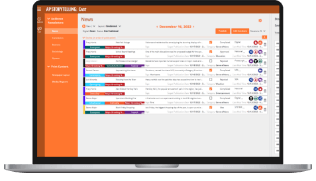
With so much content, and so many places to consume it, digital storytelling is nothing short of a modern cultural phenomenon.
This means that today’s news and media organizations are competing for audience attention across a virtual landscape that gets more crowded by the week as the the digital content industry continues to expand in revolutionary and exciting ways. Fuelling this expansion are several key trends:
Pioneering Trends in Content Creation6 influencing factors on the future of digital content | |
| Artificial Intelligence & Machine Learning | AI and ML have caused quite a stir of late. Trailblazing tools open new possibilities in digital content and journalism, from production to analysis to personalization. |
| Mixed Realities | VR (virtual reality) and AR (augmented reality) fall under the MR umbrella, offering a computer-enhanced virtual space for users to consume and interact with content in entirely novel ways. |
| Short-Form Video | Already well-established in the content industry, short-form video continues to disrupt – to the point that media giants and newsroom of all sizes have been forced to sit up and take note. |
| Reactive Content | Modern content leans heavily into ‘the reaction.’ More than ever, users engage with media that delivers a human take on current events. |
| Podcasting | Gone are the days of radio dominance for audio delivery – the podcast now reigns supreme. Consumers prefer to access their preferred shows, on-demand, from anywhere. |
| First-Party Data Collection | Following the demise of third-party data gathering, content creators and media organizations are searching for motivating factors that will encourage users to volunteer personal information. |
Below, we’ll inspect each of these trends in closer detail.
One thing to note is that news organizations striving to succeed in this new content-centric era will need forward-facing planning and production solutions such as AP Playbook or AP ENPS, to help drive them forward.
Artificial intelligence is a game-changer for journalists and other digital creators, enabling the creation of content more efficiently than ever before. But for AI to truly find a home in today’s (and tomorrow’s) newsrooms it needs to be supported by a strong ethical framework and supervised by human journalists who know their audiences and communities best.
The Associated Press was one of the first organizations to bring artificial intelligence and AI researchers into news reporting and content production. And the AP continues to be at the forefront of exploring how AI can appropriately – and responsibly – assist journalists to tell compelling stories across all mediums.
There are many AI systems and content tools around today – discover three of the most popular below.
Created by OpenAI, ChatGPT is a top example of how AI-powered content is revolutionizing the content creation industry and capturing popular imagination. ChatGPT is a natural language processing model that can generate ideas, articles, titles, social media posts – even opinionated or ‘creative’ content – with impressive accuracy, speed, and scalability.
For digital content creators, this automates time-consuming tasks, such as producing blog outlines or campaign schedules. This frees up resources for more creative endeavors.
Similarly, newsrooms and media organizations can utilize ChatGPT to help journalists and editors quickly generate news summaries; apply metadata to stories, images, and videos; or automate data analysis and reporting.
Jasper is an AI-powered tool that analyzes and produces content and offers insights on how to tailor it for SEO (search engine optimization) and social media.
Using Jasper, content creators can analyze their competitors’ content, monitor trends, and generate content ideas based on data.
In the developers’ own words, Midjourney is committed to “exploring new mediums of thought” and “expanding the imaginative powers of the human species.” It pursues this mission by giving creators a way to generate AI visual art, either as static imagery or video.
Digital creators can utilize Midjourney to create video segments, or compelling imagery, without the need to invest in costly and time-consuming manual production.
Mixed reality, encompassing both virtual reality (VR) and augmented reality (AR), is set to revolutionize the way users consume and engage with content. VR allows users to experience events in a virtual space (such as the metaverse), as if they were there, while AR can overlay information on the real world, enhancing the user’s understanding of a story.
In digital newsrooms, mixed reality technology can enable journalists to create immersive experiences that bring users closer to the story.
For example, VR can be used to transport viewers to a war zone, or to a natural disaster, giving them a firsthand experience of the situation; alternatively, AR might be used to provide context and information about a story in real-time, enhancing the user’s understanding of what’s happening around them.
Mixed reality is still a relatively new field, and there is much to learn about the implications of this technology on journalism and digital storytelling. But for those creators aiming for true story-centricity, who are willing to experiment and push the boundaries, the potential rewards are groundbreaking.
Short-form video has exploded in popularity in recent years, with platforms like TikTok, Instagram, and YouTube Shorts leading the charge. News organizations which might once have shrugged these off now see them as necessary to capture their audience’s time and attention – especially for advertiser-friendly younger audiences.
This trend has been driven by changing consumer habits and preferences, as people increasingly turn to bite-sized content that is easy to digest and share. Other reasons behind the popularity of short-form video content include:
TikTok has completely changed how users consume digital content. Its short-form format is incredibly popular with younger audiences: notably, over 70% of its global users are under the age of 34 (Statista).
The platform has been praised for its algorithm, which is seen by many as more democratic than other social media platforms. Many digital media organizations have had success with TikTok, and growth is expected to continue exponentially.
At least partly in response to the rise of TikTok, Facebook and Instagram have adapted their platforms to offer more short-form video through their Meta Stories feature.
This allows content creators to produce and share short videos with their followers, with a range of tools and features to enhance the content.
Digital creators can utilize video content with Meta Stories to reach a wider audience and engage with followers in a more interactive way.
YouTube creators are also coming around to the short-form video revolution. YouTube Shorts allows creators to make videos that are 60 seconds or less, with a focus on engaging, TikTok-style content. This presents a new way to engage with audiences on a platform that has traditionally been associated with longer-form video.
Reactive content (also called real-time content) is created in response to a specific event, with a quick turnaround time.
A key driver of this has been the rise of social media, and the 24-hour news cycle. With platforms like Twitter and Facebook, news spreads quickly, and audiences demand to see updates and commentary in real-time. Major events like elections or natural disasters require news organizations to produce near instant coverage.
Efficient software is a key component of producing reactive content. With streamlined and collaborative solutions like AP Playbook, creators can quickly plan and publish content in response to unfolding events.
Reactive content often goes hand-in-hand with opinion-driven pieces. Consequently, the future of content requires quick reactions and informed perspectives in response to real-time events.
Podcasts enable media organizations to create on-demand audio shows. Popular topics range from breaking news, to sports, to special interests and more. Crucially, podcasts allow users to consume news content on their own schedule and on the go.
Moving forward, podcasts are likely to play an even greater role in content consumption as audiences shift away from traditional audio formats like radio.
In the news industry especially, podcasts offer a way to provide in-depth coverage of events. From political commentary to true crime investigations, news podcasts offer a way to engage with audiences in a more personalized way. Suffice to say; expect to see the podcast industry continue gathering steam.
As restrictions on third-party data collection increase, organizations will increasingly focus energy on the collection of first-party user information.
Consumers are now more discerning about the brands they engage with, favoring those that align with their values and interests. Creators who utilize first-party data to produce relevant, engaging content will drive growth and enhance audience loyalty.
The trick is in finding ways to motivate consumers to volunteer their information – especially in a digital landscape where privacy is an increasing concern. Creators may be forced to gatekeep content, with access only being granted after the user has shared personal data.
While this approach may not be welcomed by all, it’s an effective way for creators to balance two competing imperatives: the need to collect data in an ethical way, and the pressure to meet audience demand.
Content creation has gathered remarkable momentum and will continue snowballing as the news and digital media industry evolves.
What is most fascinating, however, is the way digital creation is projected to develop. With so many influencing factors at work – from deep learning and AI research, to the marketing strategy organizations will adopt, to short-form videos and on-demand audio – content creators will have their hands full in the years to come. And in order to succeed content creators will need to use solutions that keep the story at the heart of the process.
Looking to improve story-centricity in your workflow? Talk to us to learn how AP Workflow Solutions can help.
Stand out from competitors with our innovative technology solutions designed to help you remove silos, increase collaboration, and boost productivity. Our suite of solutions currently includes:

AP ENPS is the world’s leading news production software, trusted by thousands of journalists in over 60 countries to streamline their news production process and deliver high-quality content.

Looking for a streamlined solution to manage your organization’s content and story planning? With our platform, you can easily monitor assignments, prioritize coverage, and increase output across any channel, making newsroom activity management simpler and more efficient than ever before.

AP Cast is a module of AP Playbook, our Planning module, designed to simplify the curation process, ensuring that your content is consistently ordered, organized, and optimized for maximum impact.
Are you ready to streamline the way your organization works? Get in touch now for a free demo of an AP Workflow Solutions product.
"*" indicates required fields
THE ASSOCIATED PRESS
Advancing the Power of Facts
The Associated Press is an independent global news organization dedicated to factual reporting. Founded in 1846, AP today remains the most trusted source of fast, accurate, unbiased news in all formats and the essential provider of the technology and services vital to the news business. More than half the world’s population sees AP journalism every day.
AP WORKFLOW SOLUTIONS
Copyright 2025 The Associated Press. All Rights Reserved.